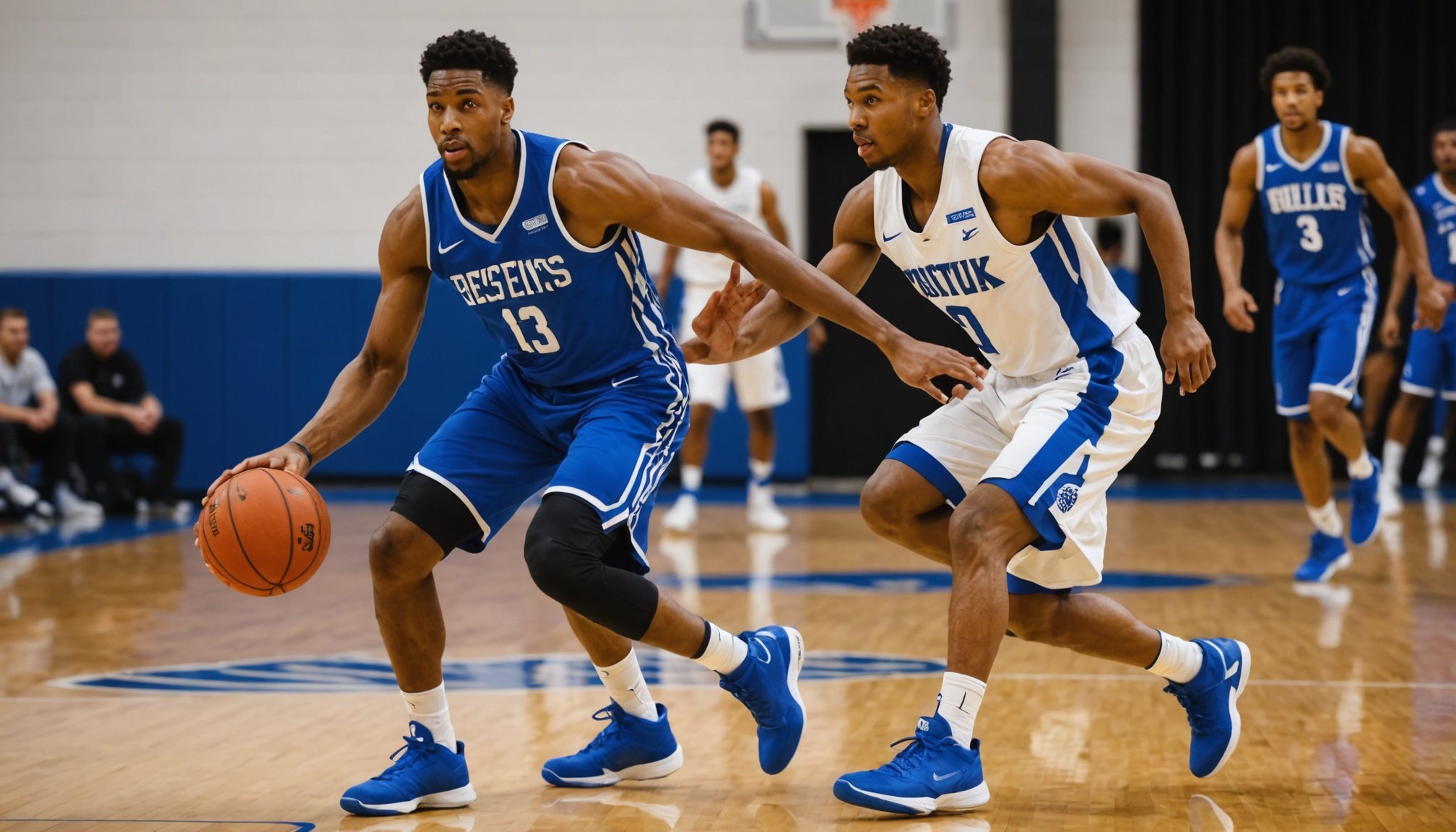Introduction to Defensive Drills
In basketball, defensive skills are crucial. They not only prevent the opposing team from scoring but also contribute to the overall success of a team. Understanding defensive drills is essential for both individual players and teams to excel in the game. These drills form the backbone of basketball training, ensuring players can react swiftly and make smart plays on the court.
An array of essential defensive drills exists to refine players’ skills. These include footwork drills that enhance agility, closeout drills that teach players how to approach opponents effectively, and communication drills that strengthen teamwork. Regular practice of these defensive drills encourages consistency and boosts team performance.
Also to discover : Unlocking mental resilience: key strategies for uk basketball players facing tough challenges
Effective defense is directly linked to team triumphs. A strong defensive strategy can disrupt an opponent’s game plan, leading to increased opportunities for offensive plays. This connection underscores the importance of dedicating training time to defense alongside offensive skills. As players engage in these drills, they develop not only their technical abilities but also their confidence on the court, contributing to the overall synergy and success of the team.
Essential Defensive Drills
In the realm of basketball defense drills, players are equipped with tools to enhance their game significantly. Defensive strategies start with fundamental drills that focus on core areas like agility, positioning, and anticipation. For instance, the zig-zag drill is pivotal in teaching players how to maintain close guard positions while navigating the court.
Also to see : Unlocking peak performance: key strategies for effective pre-game mental warm-ups in uk basketball
The objectives of these drills are multi-faceted, aiming to refine skills that directly contribute to effective defensive play. Each drill targets specific skills required for a robust defense, such as footwork, reaction timing, and spatial awareness. It’s essential to recognise how crucial consistency is in these practices. Regular engagement ensures that players not only understand the mechanics but also build muscle memory necessary for instinctual gameplay.
Equally important is the integration of advanced drills into basketball training. These incorporate complex game scenarios, enabling players to make quick decisions under pressure. With drills such as the help-and-recover or closeout, players learn to disrupt offensive plays, showcasing how proper technique and strategy blend. Emphasizing consistency and progression in practice fortifies individual capabilities and fosters cohesive team performance, ultimately leading to formidable defensive prowess.
Drills for Different Skill Levels
Understanding the diverse needs of players is crucial in basketball training, especially when incorporating defensive drills that cater to various skill levels. Tailoring the drills ensures that each player can develop their defensive prowess effectively.
Drills for Beginners
Beginner drills focus on establishing fundamental skills. Drills such as the shuffle step and mirror drill are excellent starting points, teaching beginners basic footwork and positioning. Coaches should emphasize proper technique and offer positive reinforcement to build players’ confidence. Gradual introduction of these drills helps new players grasp essential defensive concepts without overwhelming them.
Intermediate Drills
For intermediate players, drills should incorporate teamwork and communication elements. Partner closeout drills are effective for developing these skills, allowing players to practice guarding an opponent while working in synchrony with teammates. These drills bridge the gap between beginner techniques and more advanced strategies, emphasizing defensive cohesion.
Advanced Drills
Advanced drills push athletes by simulating complex game scenarios. The shell drill, for instance, tests players’ ability to make decisions under pressure, challenging them to adapt quickly. Through such challenge-based drills, coaches can assess players’ performance and strategy execution, ensuring continued growth and development in defensive skills.
Coaching Tips for Effective Implementation
Implementing coaching strategies effectively is fundamental to enhancing basketball training and boosting team performance. Coaches play a pivotal role in maximising the effectiveness of defensive drills by adopting specific techniques tailored to their team’s needs. One such technique is ensuring drills mimic real-game situations, which helps players understand practical applications and boosts their readiness during games.
Feedback is another crucial element in successful practice sessions. Coaches should provide timely, constructive feedback to help players understand their strengths and areas needing improvement. This feedback can be communicated individually or during team discussions, fostering an environment where players continually learn and adapt.
Encouraging player development requires accountability and teamwork. Establishing clear goals for both individual athletes and the team as a whole instils a sense of responsibility and motivation. When players are aware of their roles and objectives, they contribute significantly to the team’s overall synergy.
Finally, maintaining a balance between challenge and encouragement cultivates positivity in the training atmosphere. Coaches should strive to acknowledge players’ efforts while introducing increasingly challenging scenarios, thereby fostering an environment that promotes growth and excellence in defensive skills. This supportive approach enhances both morale and skill development.
Video Resources for Drill Demonstrations
Incorporating video demonstrations in basketball training can significantly enhance learning and retention of defensive skills. Basketball videos provide visual guidance, allowing players to observe and replicate proper techniques. They serve as valuable coaching resources, offering new insights and perspectives on drills that might be difficult to convey through verbal instruction alone.
Recommended video resources illustrate various drill demonstrations, focusing on different skill levels. Watching videos can help players and coaches identify nuances in movement and strategy, aiding in the mastery of complex maneuvers. For instance, platforms like YouTube host channels dedicated to basketball coaching, featuring step-by-step guides on essential defensive drills.
Integrating video analysis into training sessions not only benefits players but also empowers coaches. It allows them to identify areas of improvement, tailor strategies to suit specific needs, and foster a more interactive learning environment. Additionally, video playback can be used to review past games, offering real-time assessments of team performances.
Visual learning complements traditional training methods, making basketball training more engaging and effective. By leveraging these resources, teams can refine their defensive strategies and improve overall team performance.
Assessing Defensive Performance
Evaluating defensive performance is essential to enhancing player capabilities and team improvement. Monitoring performance not only helps in identifying strengths and weaknesses but also tailors basketball training to address specific needs.
Key Performance Indicators
Key performance indicators (KPIs) provide crucial insights into a player’s defensive mastery. Metrics like steals, blocks, and defensive rebounds are measurable aspects that reflect a player’s contribution. Tracking these over time aids in identifying areas needing refinement. A thorough evaluation at both individual and team levels ensures progress is accurately gauged.
Feedback Mechanisms
Constructive feedback is pivotal for player development. Techniques like video reviews and positive reinforcement guide players in recognising mistakes and celebrating successes. Peer evaluations can enrich this process, offering diverse perspectives that boost understanding and improvement. Adjusting training focus based on assessments ensures continuous progression.
Setting Goals for Improvement
Goal setting propels skill enhancement by establishing clear performance targets. Goals should be realistic yet challenging, focusing on improving specific defensive abilities. Encouraging players to take ownership of their defensive responsibilities fosters motivation and accountability, translating to tangible improvements on the court.











